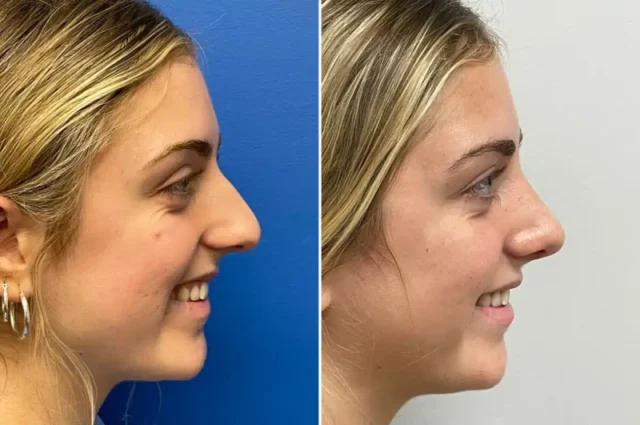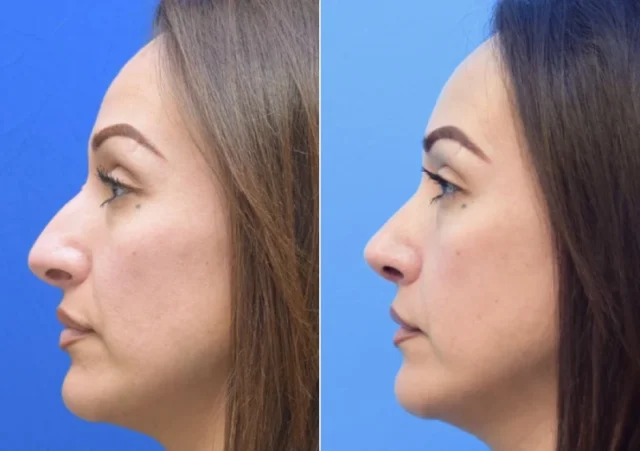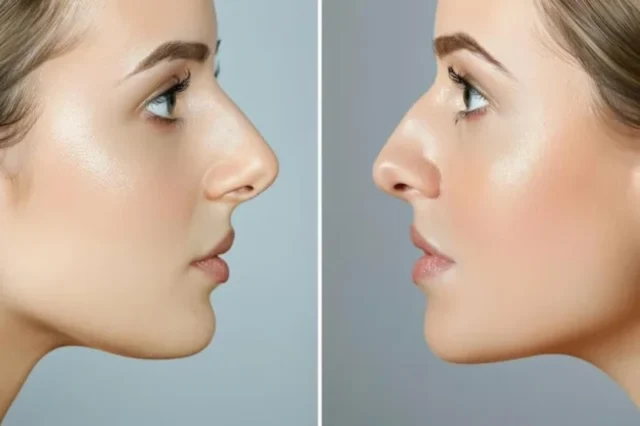In the quest for the perfect nose, the options can feel overwhelming. Traditional rhinoplasty has long been the gold standard for transforming nasal aesthetics, but a new contender has emerged: non-surgical nose jobs. These innovative procedures offer an appealing alternative, combining minimal downtime with noticeable results. Imagine enhancing your profile with a simple injection, avoiding the extensive recovery and costs associated with surgery. As beauty trends evolve, many are left wondering: are non-surgical nose jobs a viable substitute for rhinoplasty? In this article, we’ll explore the pros and cons of these non-invasive enhancements, helping you decide if they align with your aesthetic goals. From technology advancements to personal experiences, we’ll uncover whether this trending option truly holds up against the traditional surgical route. Join us as we delve into the world of non-surgical nose jobs and discover if they might be the answer to your nasal desires.
Are Non-Surgical Nose Jobs a Good Alternative to Rhinoplasty?
In the quest for the perfect nose, the options can feel overwhelming. Traditional rhinoplasty has long been the gold standard for transforming nasal aesthetics, but a new contender has emerged: non-surgical nose jobs. These innovative procedures offer an appealing alternative, combining minimal downtime with noticeable results. Imagine enhancing your profile with a simple injection, avoiding the extensive recovery and costs associated with surgery. As beauty trends evolve, many are left wondering: are non-surgical nose jobs a viable substitute for rhinoplasty? In this article, we’ll explore the pros and cons of these non-invasive enhancements, helping you decide if they align with your aesthetic goals. From technology advancements to personal experiences, we’ll uncover whether this trending option truly holds up against the traditional surgical route. Join us as we delve into the world of non-surgical nose jobs and discover if they might be the answer to your nasal desires.
Understanding Rhinoplasty: The Surgical Option
Rhinoplasty, commonly known as a “nose job,” is a surgical procedure that reshapes the nose for aesthetic or functional purposes. It is one of the most popular cosmetic surgeries globally, sought after by individuals looking to alter the size, shape, or dimensions of their noses. The procedure typically involves making incisions to access the bones and cartilage that support the nose. Depending on the desired outcome, the surgeon may remove some bone or cartilage, or add tissue, to achieve the desired shape.
A key benefit of surgical rhinoplasty is its permanence. Once the nose has healed, the results are long-lasting and do not require maintenance. This makes it an attractive option for those who want a definitive solution to their nasal concerns. Furthermore, rhinoplasty can address a variety of issues beyond cosmetic ones, such as breathing difficulties caused by a deviated septum or other structural problems. The ability to combine aesthetic and medical benefits is a significant advantage of this surgical option.
However, rhinoplasty is not without its drawbacks. It is a complex surgical procedure that requires anesthesia and a skilled surgeon. The recovery period can be lengthy, with swelling and bruising persisting for weeks or even months. There is also a risk of complications, such as infection or unsatisfactory results, which might necessitate revision surgeries. These factors, combined with the relatively high cost of the procedure, lead some individuals to consider less invasive alternatives like non-surgical nose jobs.
Benefits of Non-Surgical Nose Jobs
Non-surgical nose jobs, often referred to as liquid rhinoplasty, have gained popularity as a less invasive alternative to traditional surgery. This procedure involves the injection of dermal fillers to alter the shape of the nose temporarily. One of the most significant benefits of non-surgical nose jobs is the minimal downtime. The procedure can be completed in a matter of minutes, and patients can typically return to their daily activities immediately afterward.
Another advantage of non-surgical nose jobs is the lower risk profile compared to surgical rhinoplasty. Since there is no cutting involved, the risk of infection, scarring, or anesthesia-related complications is significantly reduced. This makes it an appealing option for those who are apprehensive about undergoing surgery or who have medical conditions that preclude them from surgical interventions. Additionally, the procedure is typically less costly than traditional rhinoplasty, making it accessible to a wider range of individuals.
The flexibility and reversibility of non-surgical nose jobs also contribute to their appeal. Since the fillers used are temporary, patients have the opportunity to “test drive” their new look before committing to permanent changes. If they are unhappy with the results, the fillers can be dissolved, and the nose returns to its original shape. This trial-and-error aspect allows for greater experimentation and customization of one’s nasal aesthetics.
Risks and Considerations of Non-Surgical Procedures
Despite their many advantages, non-surgical nose jobs are not without risks and considerations. One of the primary concerns is the temporary nature of the results. Dermal fillers typically last between six months to two years, depending on the type of filler used and individual factors such as metabolism. This means that to maintain the new nose shape, repeated treatments are necessary, which can add up in cost and time over the years.
Another consideration is the potential for complications associated with dermal fillers. While rare, there is a risk of vascular compromise if the filler is inadvertently injected into a blood vessel. This can lead to tissue damage or necrosis, which may require medical intervention. To minimize this risk, it is crucial to choose a qualified and experienced practitioner who is knowledgeable about nasal anatomy and injection techniques.
Moreover, non-surgical nose jobs have limitations in terms of the extent of changes they can achieve. They are best suited for minor adjustments, such as smoothing out bumps, enhancing the nose bridge, or refining the tip. Significant structural changes, such as reducing the size of the nose or correcting major asymmetries, are beyond the scope of what fillers can accomplish. Therefore, individuals seeking dramatic transformations may still need to consider surgical rhinoplasty.
Comparing Results: Non-Surgical vs. Surgical Nose Jobs
When it comes to results, the differences between surgical and non-surgical nose jobs are primarily in the scope and permanence of the changes. Surgical rhinoplasty can achieve more substantial alterations in size, shape, and overall nasal structure. This makes it ideal for individuals seeking significant changes, such as reducing the size of a prominent nose or correcting congenital or traumatic deformities. The results are permanent, providing long-term satisfaction without the need for ongoing treatments.
In contrast, non-surgical nose jobs offer more subtle enhancements that can refine and balance the nasal features. They are particularly effective for addressing minor asymmetries, smoothing out dorsal humps, or lifting a drooping nasal tip. The temporary nature of the fillers allows for adjustments and refinements based on personal preferences or evolving beauty trends. However, they cannot reduce the size of the nose or correct functional issues, which are capabilities reserved for surgical interventions.
Ultimately, the choice between surgical and non-surgical nose jobs depends on the individual’s aesthetic goals, tolerance for risk and downtime, and budgetary considerations. Those seeking transformative changes with long-lasting results may lean towards rhinoplasty, while those interested in minor tweaks with minimal commitment may find non-surgical options more appealing. Consulting with a skilled practitioner can help in determining the most suitable approach based on one’s unique needs and circumstances.
The Procedure: What to Expect During a Non-Surgical Nose Job
The procedure for a non-surgical nose job is relatively straightforward and quick, often completed within 15 to 30 minutes. It begins with a consultation where the practitioner assesses the patient’s nose and discusses their aesthetic goals. This step is crucial to ensure that the expectations are realistic and that the desired outcomes align with what the procedure can achieve. Once a treatment plan is agreed upon, the actual procedure can begin.
Before the injections, a topical anesthetic may be applied to the nose area to minimize discomfort. Some practitioners also use ice or vibration devices to further reduce pain during the injection process. The dermal fillers, which are typically composed of hyaluronic acid, are then strategically injected into specific areas of the nose to achieve the desired shape and contour. The practitioner may massage the area gently to mold the filler and ensure smooth, even results.
After the injections, patients can immediately see the changes, although there may be some minor swelling or redness that subsides within a few hours to a couple of days. There is little to no downtime, and individuals can usually resume their normal activities right away. Some practitioners might provide post-procedure care instructions, such as avoiding touching the nose, strenuous activities, or wearing glasses that rest on the nose bridge for a short period.
Recovery and Aftercare for Non-Surgical Nose Jobs
The recovery process for non-surgical nose jobs is typically minimal, with patients experiencing little to no downtime. Most individuals can return to work or social activities immediately after the procedure, with only mild swelling or redness that dissipates quickly. This makes non-surgical nose jobs an attractive option for those with busy lifestyles who cannot afford extended time off for recovery.
After the procedure, it is essential to follow the aftercare instructions provided by the practitioner to ensure the best results and minimize any potential complications. These may include avoiding strenuous exercise, excessive heat, or pressure on the nose for a day or two. Patients are also advised to refrain from wearing glasses that rest on the nose until the filler has settled, which usually takes a few days.
While the recovery is straightforward, it is crucial to monitor for any signs of complications, such as persistent swelling, redness, or pain that does not subside. In rare cases, if the filler is inadvertently injected into a blood vessel, it can lead to vascular complications that require prompt medical attention. Regular follow-ups with the practitioner can help address any concerns and ensure the longevity of the results.
Cost Analysis: Non-Surgical vs. Rhinoplasty
The cost of non-surgical nose jobs is generally lower than that of traditional rhinoplasty, making them a more accessible option for many individuals. The price for a non-surgical procedure can range from $600 to $1,500 per session, depending on the practitioner’s expertise, geographic location, and the amount of filler required. In contrast, surgical rhinoplasty costs significantly more, often ranging from $5,000 to $15,000, depending on the complexity of the surgery and the surgeon’s reputation.
While non-surgical nose jobs are less expensive upfront, it is important to consider the ongoing maintenance costs. Since the fillers are temporary, repeat treatments are necessary to maintain the desired results, which can add up over time. On the other hand, surgical rhinoplasty, though more costly initially, provides permanent results, eliminating the need for future procedures.
Ultimately, the decision between non-surgical and surgical options should be based on individual goals, budgetary constraints, and the desired longevity of results. For those seeking a cost-effective, temporary solution with minimal downtime, non-surgical nose jobs may be ideal. However, individuals looking for a one-time investment with lasting outcomes might find rhinoplasty to be a more worthwhile choice.
Who is an Ideal Candidate for Non-Surgical Nose Jobs?
Non-surgical nose jobs are suitable for individuals seeking minor cosmetic enhancements to their nasal appearance without undergoing surgery. Ideal candidates are those who wish to address specific concerns, such as smoothing out small bumps, straightening the nose bridge, or refining the tip. These procedures are particularly effective for individuals with realistic expectations who understand the limitations and temporary nature of the results.
Candidates should be in good overall health and free from any medical conditions that could affect the healing process or increase the risk of complications. It is also essential for individuals to have a stable mental outlook and a clear understanding of the procedure’s potential outcomes. Those with significant structural issues, functional impairments, or a desire for dramatic changes may be better suited for surgical rhinoplasty.
Consultation with a qualified practitioner is crucial in determining candidacy for non-surgical nose jobs. During this consultation, the practitioner will evaluate the individual’s nasal anatomy, discuss their aesthetic goals, and provide guidance on the most appropriate treatment options. Open communication and a thorough understanding of the procedure can help ensure that candidates make informed decisions about their nasal enhancements.
Conclusion: Making the Right Choice for Your Nose Aesthetic
Navigating the world of nasal aesthetics can be complex, with both surgical and non-surgical options offering distinct benefits and limitations. Non-surgical nose jobs provide a compelling alternative for those seeking minor enhancements with minimal commitment. The procedure’s appeal lies in its quick execution, reduced downtime, and lower cost, making it accessible to a broader audience.
However, the temporary nature and limitations of non-surgical procedures mean they are not suitable for everyone. Individuals seeking significant alterations or permanent solutions may still find surgical rhinoplasty to be the better option. Ultimately, the decision should be based on personal preferences, aesthetic goals, and a thorough understanding of each procedure’s potential outcomes and risks.
Consulting with experienced professionals and considering one’s long-term aspirations are crucial steps in making an informed choice. Whether opting for the transformative power of surgery or the subtle finesse of fillers, the journey towards achieving the perfect nose is deeply personal and should align with one’s vision of beauty and self-confidence.




